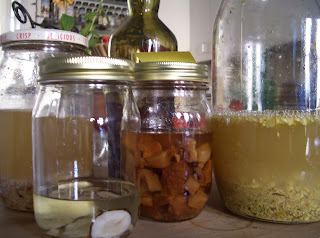Harvesting and Drying Roots
I've been the coordinator of the herb garden at 6/15 Green Community Garden for ten years now. When I inherited the job it was a rubble strewn sloping weed patch with a large comfrey plant and a whole lot of lemon balm and mint. I organized some members to double dig it and sift out the rubble. The soil was amended with loads of compost and it was well worth all of the labor. The soil is gorgeous - and if you're someone who loves to garden you know that soil can be gorgeous.
This was a really good year for the herb garden. A lot of plants have gotten more established and are coming into their full glory. Every year we add plants and it's now looking like a full lush garden with plenty of medicinal and culinary herbs. However, the plot needs some order. October is a great time to transplant so fellow member Elizabeth Kalin and I have spent some time the past two weekends working hard on making next summer even better.
We moved larger plants out of the paths so we could get into the plot with greater ease. In so doing we moved the large marshmallow plants. When I dug them up they divided easily so I planted most of them in the back of the plot and took home some roots to dry for winter.
Marshmallow root is a mucilagenous plant that is very soothing for inflammation and ulceration of the stomach and small intestine. It's also useful for dry cough as it soothes the throat and expectorates. It is also the source of the original marshmallow confection. Commercial marshmallows substitute gelatin for the root. I've searched far and wide for a recipe and will try my hand at making the real thing this winter (to have with hot cocoa). In case anyone feels brave and wants to try it:
Marshmallows from Real Marshmallow Root
1/4 cup dried marshmallow root
1 and 3/4 cups sugar
1 and 1/4 T gum tragacanth
2 cups water
2 egg whites, whipped,
2 t rosewater or orange flower water to taste
Simmer the toot in 1 and 1/2 cups of water for about 20 minutes. Soak the gum in 1/2 cup water. Stir the gum vigorously and plop it in the blender and cover and wait until the cooking root has made a slightly mucilaginous tea. Strain out the root liquid into the blender and blend the root liquid with the gum paste very thoroughly. Put this into a saucepan over a very low heat and stir. It will be rubbery and will soften a little. Add the sugar and whisk for a few minutes. Quit when a candy thermometer reads 215. Whip for two minutes. Add the egg whites, beating a bit more to blend. It will be very sticky. "Pour" into a powdered sugar pan and wait to dry. They are crunchy on the outside and melting on the inside when they're done. Refrigerate. (Recipe from lostpastremembered.blogspot.com)
We also dug up some angelica root. The angelica plant has been a great source of amusement this past summer. It was actually the original source of inspiration for making herb infused vodka. The plant is an umbelifer in the same family as celery. The stalk and leaves have a similar flavor and aroma but with a twist. I discovered that it is the main ingredient in Chartreuse. Angelica is good for indigestion, anemia, coughs and colds and is said to be warming.
 |
| Angelica root |
 |
| Angelica seed |
 |
| Angelica root |
 |
| http://www.etsy.com/listing/25365753/carmelite-water-by-herbal-alchemy |






